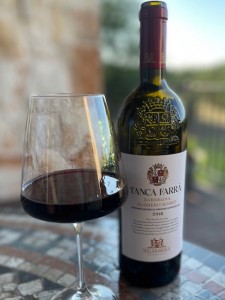By Neil Duarte
In 1899 two travelers from Piedmont, one an engineer named Sella and the other a lawyer named Mosca, visited the island of Sardinia. There they fell in love with the potential of the island for winemaking and started what is today the Sella&Mosca Winery. Located on the northwestern part of the island are Sella&Mosca’s 520 hectares comprising the Alghero estate, one of the largest wine estates in Europe, where the winery produces both DOC red and white wines. On the northeastern side of the island Sella&Mosca has another 120 hectares where more Vermentino grapes are grown. There is also a small 6 hectare vineyard on the southwestern side of the island where the Carignano grape is grown.
My wife and I have visited almost every region of Italy except the island of Sardinia and I was curious about the wines from there. My friends at Wellcom wine marketing sent me some information on Sella&Mosca and arranged for the winery’s US importer, Taub Family Selections, to send me some samples to taste. Here are the results of my tasting of the three white wines and three red wines that were sent to me. All were tasted along with meals prepared by my excellent cook wife.
The initial wine was a 2020 Alghero Torbato Spumante Brut DOC, a 12% alcohol offering made from 100% Torbato grapes. This grape is found only in Sardinia and Sella & Mosca is literally the only producer. The grapes were soft pressed with cold settling and then selected yeasts were added. The initial fermentation was in stainless steel tanks at controlled temperatures and the second fermentation was in stainless steel tanks for 20 days. Aging for three months in stainless steel tanks followed. The resultant Alghero Torbato Spumante Brut was a very pale straw color with a very light nose. It finished with nice acidity, light but pleasant. We drank this with various cheese and meat cold cuts and it was an excellent accompaniment to these. My wife even made a peach Bellini mixing the wine with pureed fresh peaches. I rated this wine an 89 and recommend it as an aperitif.
The second white was a 2021 La Cala Vermentino di Sardegna DOC made from 100% Vermentino grapes grown in the Alghero area. The La Cala was a 12.5% alcohol wine that was made from grapes that were soft pressed, and then cold settled. Fermentation was in stainless steel tanks at a controlled temperature of 18°C. A short period of aging in stainless steel tanks followed. The resultant La Cala was pale straw in color with a light fruit nose. It was served with a dinner of pan fried chicken breast accompanied by linguine in a homemade pistachio pesto sauce and tomatoes stuffed with Italian cheese and baked. The La Cala finished medium and smooth and I rated it an 89.
The third white was a 2020 Monteoro Vermentino di Gallura Superiore DOCG, a 14% alcohol wine made from 100% Vermentino grapes grown on the south side of Mount Limbara in the Gallura area. The grapes were soft pressed with cold maceration in stainless steel tanks at controlled temperature and left to ferment. Aging was on the lees in stainless steel tanks for four months. The resultant Monteoro Vermentino was a straw yellow in color with a very light fruit nose. It was served with Involtini di Pollo (chicken thighs stuffed with Italian breadcrumbs and cheese) accompanied by rice cooked with artichoke hearts and mushrooms in a white wine sauce. This excellent white wine finished medium long and very smooth. I loved the MONTEORO and rated it a 92/93. It was superb with this meal.

The Tanca Farra wine. PHOTO: TERRY DUARTE
Our second wine was a 2019 Cannonau Di Sardegna Riserva DOC, a 13.5% alcohol offering made from 100% Cannonau grapes. The Cannonau was fermented at controlled temperatures. Aging was for eight months with part in large oak casks and the remainder in stainless steel tanks. The resultant wine was ruby in color with a very light nose. It was served with grilled beef steaks accompanied by fried potatoes and grilled tomatoes. The Cannonau finished medium long and very smooth and I rated it a 91.
The last wine was a 2016 Marchese di Villamarina Alghero Cabernet Riserva made from 100% Cabernet Sauvignon grapes. This 13.5% alcohol Bordeaux style offering had pre-fermentation cold maceration at 10°C for 24 hours followed by fermentation at controlled temperatures. Aging was for 18 months with half in new French oak barriques and the other half in second use French oak barriques. Final aging was for 12 months in the bottle. The resulting wine was a very dark ruby in color with an excellent fruit nose. The Marchese di Villamarina was served with grilled beef steaks accompanied by roasted potatoes, grilled zucchini and squash. It finished medium long and very, very smooth. I loved this excellent European style Cabernet and rated it a 93/94.
My initial Sardinian wine tasting proved to be most impressive and I highly recommend all of the Sella&Mosca wines I tasted.
Thanks to Wellcom and Taub Family Selections for providing these wines.




